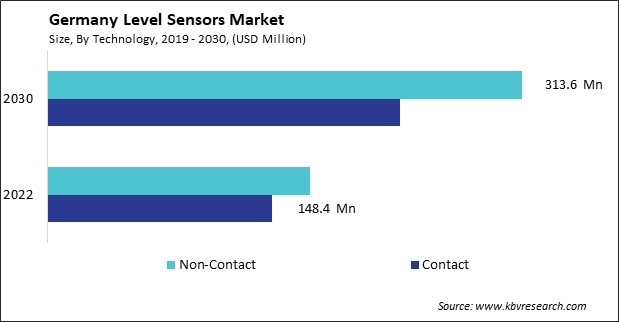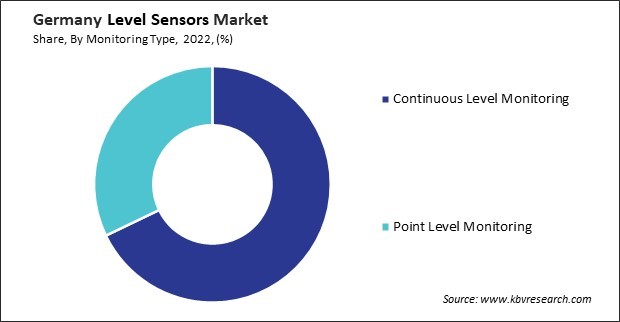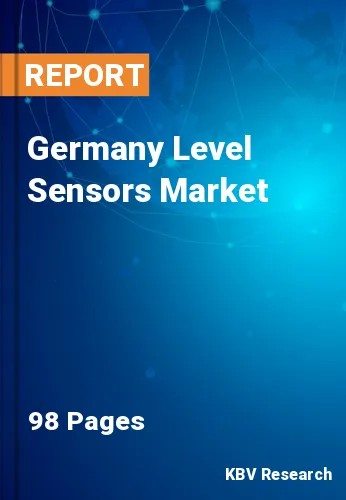The Germany Level Sensors Market size is expected to reach $546.6 Million by 2030, rising at a market growth of 6.9% CAGR during the forecast period. In the year 2022, the market attained a volume of 1,941.65 Thousand Units, experiencing a growth of 10.5% (2019-2022).
The level sensors market in Germany has witnessed substantial growth in recent years. Germany is a prominent hub for manufacturing and industrial activities. In the automotive industry, level sensors are used to monitor vehicles' fuel levels, coolant levels, and hydraulic fluid levels. According to the Germany Trade & Invest in 2021, Germany is Europe's biggest automotive industry, number one in production and sales terms, accounting for around 25% of all passenger cars manufactured and almost 20% of all new registrations. With Germany home to several leading automobile manufacturers and suppliers, the demand for advanced level sensing technologies continues to rise.

In the pharmaceutical sector, level sensors play a critical role in precisely measuring liquid ingredients during manufacturing. According to Germany Trade & Invest, Germany stands as a prominent global hub for pharmaceutical production, boasting a substantial increase in production volume, reaching EUR 34.6 billion in 2021 with a remarkable 6.9 % year-on-year growth. In 2022, a notable surge in pharmaceutical industry sales within Germany occurred, marking a 5.4 % increase and reaching EUR 56.5 billion. These sensors help pharmaceutical companies maintain product quality, optimize production efficiency, and comply with stringent regulatory requirements.
However, COVID-19 has significantly impacted the level sensors market in Germany. The pandemic led to disruptions in supply chains, temporary shutdowns of manufacturing facilities, and a slowdown in industrial activities during certain periods. Moreover, a growing focus has been on implementing advanced sensor technologies, including level sensors, to enable remote monitoring and control of processes. As a result, there has been increased interest in IoT-enabled level sensors and cloud-based monitoring solutions that offer enhanced visibility and actionable insights into industrial processes.
The level sensors market in Germany is experiencing a significant shift driven by the growing adoption of Internet of Things (IoT) technologies. One key driver behind the adoption of IoT in the level sensors market is the demand for real-time monitoring and remote management capabilities. IoT-enabled level sensors transmit data wirelessly to centralized systems or cloud platforms, allowing for instant access to critical information from anywhere in the world.
Another factor driving the adoption of IoT in level sensors is the increasing focus on predictive maintenance. By leveraging IoT technologies such as machine learning and predictive analytics, these sensors provide early warnings of potential equipment failures or maintenance issues, allowing companies to address them proactively before they escalate into costly problems.
Furthermore, IoT-enabled level sensors offer enhanced scalability and flexibility compared to traditional wired sensors. According to Germany Trade & Invest, with the IoT expenditure in Germany exceeding EUR 35 billion and IoT-generated revenue doubling from EUR 22.5 billion in 2018 to EUR 45 billion in 2023, the technological landscape is undergoing significant transformation. This scalability allows German businesses to deploy sensors across multiple sites or locations, enabling centralized monitoring and management of their entire operation from a single interface.
Moreover, the proliferation of IoT platforms and ecosystems drives innovation and collaboration in the level sensors market. German companies are partnering with IoT platform providers, software developers, and other stakeholders to create integrated solutions that deliver added value to customers. Hence, the surge in IoT adoption is revolutionizing the level sensors market in Germany, offering real-time monitoring, predictive maintenance, scalability, and fostering collaboration for integrated solutions.
In Germany, the level sensors market is experiencing a notable uptick in growth, largely propelled by the country's steadfast commitment to renewable energy sources. This shift towards renewables necessitates advanced monitoring and control systems to manage energy production and distribution efficiently. Level sensors are crucial in accurately measuring liquid and gas levels in renewable energy infrastructure such as storage tanks, reservoirs, and pipelines.
One of the primary drivers behind this growth is the increasing reliance on renewable energy sources such as wind and solar power. According to the International Trade Administration, the country has set ambitious targets to source 80% of its energy from renewables by 2030. By 2022, Germany had made significant progress, achieving 46% of this goal. Renewable sources constituted a substantial 42.3% share of the domestic energy mix. Germany has been aggressively expanding its renewable energy capacity to transition away from fossil fuels and reduce greenhouse gas emissions.
Furthermore, government initiatives and policies have been instrumental in fostering the growth of renewable energy technologies, creating a favorable environment for adopting advanced sensing solutions. Substantial investments in renewable energy infrastructure, coupled with supportive regulations and incentives, have encouraged industries in Germany to embrace sustainable practices and incorporate innovative technologies like level sensors into their operations.
Moreover, Germany's increasing focus on environmental sustainability and energy efficiency is driving demand for smart sensor solutions. Germany's commitment to renewable energy and sustainability is fueling the rapid growth of the level sensors market, driving innovation and adoption across industries. Thus, Germany's commitment to renewable energy and sustainability is propelling the rapid expansion of the level sensors market, fostering innovation and adoption across industries.

The level sensors market in Germany is a significant segment of the country's industrial landscape, serving a wide range of industries, including automotive, manufacturing, chemical, pharmaceutical, and food processing. One of the prominent players in the German level sensors market is Siemens AG, a multinational conglomerate with a strong presence in industrial automation and control systems. Siemens offers a comprehensive range of level sensors, including ultrasonic, radar, and capacitive sensors, designed for precise and reliable level measurement in diverse industrial environments. The company's sensors are known for their accuracy, durability, and advanced features, making them ideal for water treatment and chemical processing applications.
IFM Electronic GmbH is another significant player in the German level sensors market. The company specializes in sensor and control system solutions for industrial automation. Its portfolio includes various types of level sensors, such as capacitive, ultrasonic, and float sensors, designed to provide accurate and reliable level measurements in liquids and bulk materials. IFM's sensors are known for their innovative features, ease of installation, and compatibility with different process conditions, making them popular among German manufacturers.
Another major player in the German level sensors market is Endress+Hauser Group, which specializes in process measurement and automation solutions. Endress+Hauser's portfolio includes various level sensors, such as radar, ultrasonic, capacitance, and hydrostatic sensors, catering to different industry requirements. The company's sensors are recognized for their high accuracy, robustness, and compatibility with various process conditions, making them suitable for use in demanding applications across different sectors.
SICK AG, a global technology company headquartered in Germany, is also active in the German level sensors market, offering a wide range of sensor solutions for industrial automation and process control. The company's portfolio includes ultrasonic, radar, and capacitive-level sensors designed to meet the demanding requirements of modern manufacturing and processing industries. SICK's sensors are recognized for their high performance, reliability, and versatility, making them suitable for various applications across different sectors.
In addition to these key players, several other companies, including Baumer Group, Krohne Group, and VEGA Grieshaber KG, contribute to the vibrant landscape of the German level sensors market. These companies offer diverse level sensing solutions tailored to specific industry needs, driving innovation and competitiveness in the industry. With Germany's reputation for engineering excellence and commitment to quality, the level sensors market is poised for continued growth and expansion, offering opportunities for established players and emerging startups to thrive and contribute to the country's industrial success.
By Technology
By Monitoring Type
By End User
Our team of dedicated experts can provide you with attractive expansion opportunities for your business.

